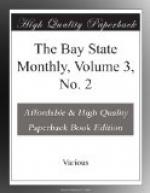The foundation of this school was soon followed by several others. Charlestown had a school in 1636, Salem and Ipswich in 1637, and the Eliot school in Roxbury was established in 1645. The Latin school was alone in Boston, however, for nearly fifty years, and it was wisely cherished and nurtured by the town. Mr. Pormout was paid a salary of sixty pounds a year, a sum considered comportable to the talent employed, and the grave responsibilities of the position.
The masters who succeeded to Mr. Pormout are, in their order: Rev. Daniel Maude, Rev. John Woodbridge, Robert Woodmansie, Benjamin Thompson, Ezekiel Cheever, Rev. Nathaniel Williams, and John Lovell, whose rule continued for forty-two years, or until the Revolutionary war. Among Lovell’s pupils was Harrison Gray Otis. During the excitement of the war, the school was closed for a short time, but was again opened in June, 1776, under the rule of Mr. Samuel Hunt. He was in authority for twenty-nine years and was then succeeded by William Bigelow of Salem, who held the sceptre until 1813, when it passed to Benjamin Apthorp Gould, and in 1828 to Frederick P. Leverett. The later masters have been Charles K. Dilloway, who succeeded in 1831, Epes Sargent Dixwell in 1836, Francis Gardner in 1851, Augustine W. Gay in 1876, and in 1877 Moses Merrill, the present efficient master. Among these many school teachers, some have been famous for their marked abilities. This is especially true of Ezekiel Cheever, John Lovell, and Francis Gardner.
“Cheever and Lovell and Gardner, the Puritan, the Tory, and shall not we say, in some fuller sense, the man—are they not characteristic figures? One belongs to the century of Milton, one to the century of Johnson, one to the century of Carlisle. One’s eye is on the New Jerusalem; one’s soul is all wrapped up in Boston; one has caught sight of humanity. One is of the century of faith, one of the century of common-sense, one of the century of conscience. One leaches his boys the Christian doctrine, one bids them keep the order of the school, one inspires them to do their duty. The times they represent are great expanses in the sea of time. One shallower, one deeper than the other; through them all sails on the constant school with its monotonous routine, like the clattering machine of a great ship which over many waters of different depths, feeling now the deepness and now the shallowness under its keel, presses along to some sea of the future which shall be better than them all."[1]
The first school-house stood until 1748. Another was then erected on the opposite side of School street, where the Parker House now stands. In 1812 a new building was erected here. The Latin school was moved in 1844 to Bedford street, where it occupied the building recently torn down, until 1881, when the magnificent structure on Warren Avenue became its home.




